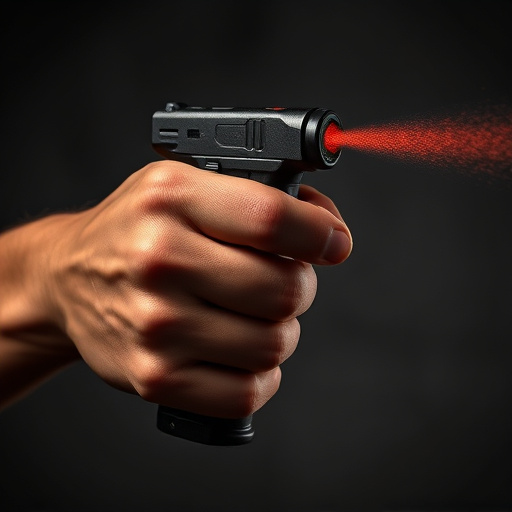Understanding the severe physiological impacts of pepper spray exposure is crucial. Immediate first aid, including thorough water rinsing, removing contaminated clothing, applying cold compresses, and moving to fresh air, soothes symptoms like intense pain, blurred vision, coughing, and breathing difficulties. Long-term effects require professional medical care. Proper aftercare involves cleaning and moisturizing the affected area, using cool compresses for irritation, and seeking medical attention for severe reactions. Preventing reoccurence includes proper storage, disposal, and understanding legal considerations regarding pepper spray use.
“Civilian defense pepper spray can be a powerful tool for personal safety, but understanding its effects and proper usage is crucial. This comprehensive guide delves into the various aspects of pepper spray exposure, from immediate concerns and risks to essential aftercare steps. We explore first aid measures for ocular, respiratory, and other potential injuries, as well as prevention strategies for responsible storage, disposal, and legal considerations. Learn how to effectively manage pepper spray incidents with our expert advice on pepper spray aftercare and first aid.”
- Understanding Pepper Spray Exposure: Immediate Concerns and Risks
- Essential Steps for Pepper Spray Aftercare: Soothing and Healing the Skin
- First Aid Measures: Treating Ocular, Respiratory, and Other Potential Injuries
- Preventing Reoccurence: Storage, Disposal, and Legal Considerations for Civilian Defense Pepper Spray
Understanding Pepper Spray Exposure: Immediate Concerns and Risks
Understanding Pepper spray exposure is crucial, as it can have immediate and long-term effects on the human body. When pepper spray comes into contact with eyes, skin, or respiratory system, it triggers a severe reaction. Immediate concerns include intense pain, blurred vision, coughing, difficulty breathing, and temporary blindness. These symptoms can last for several minutes to hours, making it vital to seek immediate medical attention if these arise.
Proper first aid is essential after pepper spray exposure. This includes thoroughly rinsing the affected areas with water for at least 15 minutes. Removing any contaminated clothing or footwear is also important. Applying a cold compress can help reduce swelling and pain in the eyes. For respiratory distress, moving to an area with fresh air is crucial. If symptoms persist or worsen, professional medical care should be sought as soon as possible to address potential long-term effects and ensure proper pepper spray aftercare.
Essential Steps for Pepper Spray Aftercare: Soothing and Healing the Skin
After using pepper spray, proper aftercare is crucial for soothing and healing the skin. The first step is to immediately rinse the affected area with plenty of clean water for at least 15 minutes. This helps to dilute and wash away any remaining pepper spray chemicals. It’s important to note that in cases of severe exposure or if irritation persists, seeking medical attention should be prioritized.
Once rinsed, gently pat the skin dry with a soft cloth. Avoid rubbing, as it can further irritate the skin. You can then apply a cool compress to reduce any swelling or discomfort. Using a gentle, hypoallergenic moisturizer can also help calm and heal the skin. In terms of first aid, keeping the affected area clean and moisturized will support the natural healing process.
First Aid Measures: Treating Ocular, Respiratory, and Other Potential Injuries
In the event of exposure to pepper spray, prompt first aid measures are crucial for minimizing potential injuries and ensuring proper aftercare. If pepper spray comes into contact with the eyes, immediately flush them thoroughly with clean water for at least 15 minutes. This helps to remove any residual spray particles, alleviating irritation and discomfort. For respiratory issues, move the affected individual to an area with fresh air. If breathing is difficult, administer oxygen if trained to do so, or encourage slow, deep breaths to aid in clearing the airways.
Other potential injuries may include skin irritation or burns, rashes, and difficulty standing due to muscle spasms. In such cases, apply cool compresses to affected areas for pain relief and reduce swelling. Remove any contaminated clothing and wash the skin with mild soap and water. If symptoms persist or severe reactions occur, seek immediate medical attention. Proper first aid measures after pepper spray exposure are essential to prevent long-term health issues and ensure a swift recovery.
Preventing Reoccurence: Storage, Disposal, and Legal Considerations for Civilian Defense Pepper Spray
Preventing Reoccurence: Storage, Disposal, and Legal Considerations for Civilian Defense Pepper Spray
Proper storage is a crucial step in ensuring pepper spray remains effective and readily available when needed. Keep the canister in a cool, dry place away from direct sunlight or extreme temperatures. Avoid leaving it in vehicles, as fluctuations in temperature can compromise its integrity. Store it out of reach of children and unauthorized individuals to maintain safety. Regularly check the expiration date, as pepper spray can lose its potency over time, necessitating replacement.
Disposal is another important aspect of pepper spray aftercare. Never dispose of used canisters in regular trash; instead, follow local regulations for hazardous waste disposal. Some areas may have specific drop-off locations or collection events for such items. Additionally, familiarize yourself with the legal implications of possessing and using pepper spray. Understand the laws in your region regarding self-defense and the permitted use of pepper spray to avoid any legal complications or misuses that could lead to reoccurrence.
In conclusion, while pepper spray can be a valuable tool for civilian defense, proper understanding and aftercare are paramount. Effective first aid measures, including ocular and respiratory care, are essential following exposure. By adhering to recommended storage, disposal, and legal guidelines, users can minimize potential risks and prevent reoccurrence. Remember, responsible usage and thorough knowledge of pepper spray aftercare are key to ensuring its effectiveness as a personal defense mechanism.
